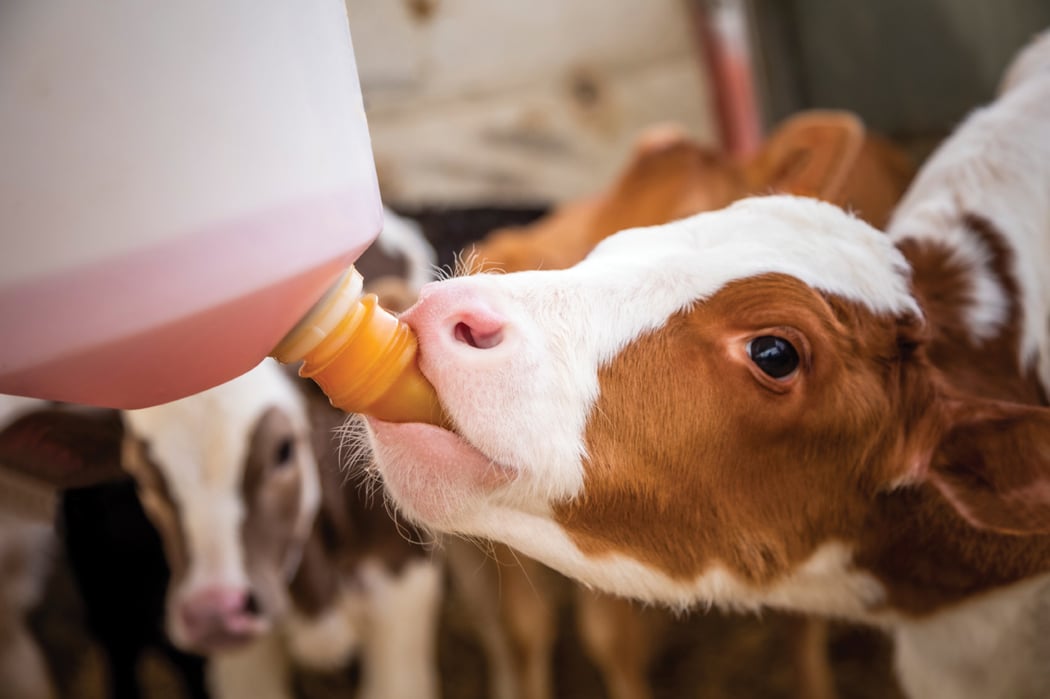Heat stress in calves
Animals have a thermoneutral zone (TNZ), a range of temperatures in which heat production and heat loss are balanced and the body can maintain its core temperature. Calves have an upper critical limit of 25°C, however they will start to feel the effects of heat stress at 21°C.
Temperature humidity index (THI) is a measure that accounts for the combined effects of environmental temperature and relative humidity. It is good practice to have a thermometer in calf housing to monitor the temperature daily at calf level. Above 20°C or when THI reaches 65 [2], heat stress prevention methods should be implemented and calves should be closely monitored.
Heat stress results in energy being diverted from growth and immune development into thermoregulation and mechanisms such as sweating, increased respiration rate and panting, drinking excessively and spending less time lying down. This redistribution of energy, coupled with reduced milk volume and dry matter intake (DMI), can result in a reduced growth performance and an increased likelihood of dehydration and diarrhoea.
Calves have an increased risk of disease incidence and morbidity alongside a reduced average daily gain (ADG). It has been reported that dairy calves born in summer tended to have a lower ADG than those born in winter [3]. Lower growth rates can have long-term impacts, affecting insemination and age of first calving. However, heat stress has many physiological effects that occur before clinical signs show.
As energy is diverted to regulate body temperature, a lower immune status results in an increased susceptibility to pathogens and risk of bacterial infection. The exposure to heat could enhance cellular reactive oxygen species (ROS) production and the generation of free radicals, leading to oxidative stress and damage to cells and organelles. Calves are exposed to diverse range of stress stimulants including heat stress, which alters the oxidative balance of the calves. High levels of stress, especially prolonged stress can have long-term negative impacts on calves, such as inflammatory reactions and a weakened immune system resulting in the calf suffering from diarrhoea.
Rumen development is supported through increased starter intake. During heat stress, high amounts of starch from starter can risk ruminal acidosis and bypass the rumen to damage the lower gut intestinal barrier. As well as this, increased blood flow to the skin and extremities results in a decreased blood flow to the gastrointestinal tract, increasing intestinal permeability. These factors contribute to the development of leaky gut syndrome, which occurs when tight junctions between the enterocytes become disjointed and permeable to potentially harmful molecules, allowing them to enter systematic circulation.
To try and regulate body temperature, calves will increase their respiration rate and begin to pant. This causes reduced CO2 concentration in the blood, increasing blood pH. As a result, there is an electrolyte imbalance, compounded by sweating and increased urination, and the calf becomes dehydrated.
Prevention is key
When it comes to heat stress, prevention is key. There are many strategies that can be implemented to support calves when temperature or humidity rises. Examples include:
- Offering shade to calves in warm weather. This is a quick and effective way of helping them to regulate their temperature. Well-designed shaded areas could reduce solar radiation by up to 90% [4].
- Handling in the cooler parts of the day either in the evening or first thing in the morning helps to reduce the overall stress burden on the calf.
- Increasing air flow and air exchange, while ensuring there are no draughts, is very effective at supporting calves when it is hot. Installing mechanical ventilation, such as fans or tubes, may be a consideration depending on housing set up.
- Elevating hutches on one side has been shown to decrease internal hutch temperature and increase ventilation in warm weather.
- Reducing stocking density can help if in group housing.
- Implement strategies to reduce the fly population. Flies cause the calf stress and fly control practises should be considered, such as cleaning and sanitising equipment regularly will help to minimise the risk of infection or disease and help control fly populations. Bedding should be clean and dry and changed frequently to support the calf and prevent the establishment of fly populations.
- Fresh starter, clean and free from moisture, to encourage calves to eat and develop their rumen.
- Clean water should be constantly available, not only to reduce the risk of dehydration but also to support rumen development.
- Increasing feeding frequency of milk or milk replacers can provide calves with more energy to support growth and performance, as well as thermoregulation. Healthy calves are unlikely to refuse to drink milk.
- Consider increased feeding. Research has shown that calves fed three times a day have displayed optimal growth, better feed efficiency, consume more starter prior to weaning and have greater chance of survival to lactation than calves fed twice daily
- Pre-emptive application of Oral Rehydration Solutions (ORS), such as OsmoFit, to replenish electrolytes and maintain hydration status. Dehydration calves are susceptible to further issues such as metabolic acidosis.
Application of Oral Rehydration Solutions – consider a proactive approach
When calves become heat stressed and clinical signs start to show, it is important to preserve the electrolyte balance and water intake. In warm weather, calves are more prone to dehydration. Early signs of dehydration include sunken eyes, slow to drink or respond during feeding time and sluggish behaviour. Pinch tests can be used to determine if a calf is dehydrated. Calves suffering from dehydration or diarrhoea should receive an oral electrolyte solution, such as OsmoFit, proactively in addition to the milk feeds, particularly around midday.
